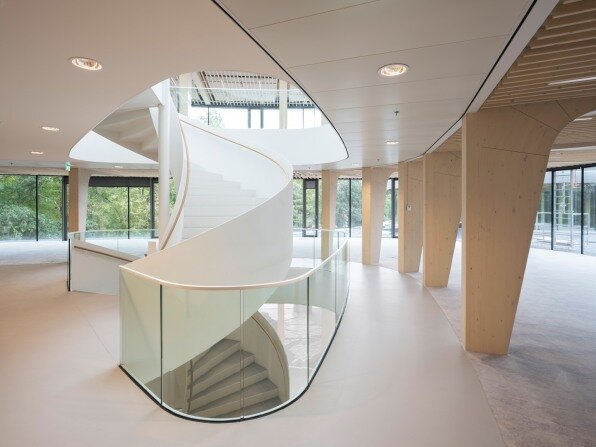One day, this new Dutch office building will reach the end of its life. Instead of being demolished, each piece of the structure will be reused somewhere else. The floor can be demounted. The windows covering the facade can be installed in another office. The building, which houses the Netherlands-based Triodos Bank, was designed to be fully circular.
Built primarily from wood, with towers ranging from two stories to five stories, the building was constructed using 165,312 screws—so if the company ever needs to relocate, or if the office closes, all of the components can be easily disassembled, unlike a steel building that would be welded together and girded with concrete. “We want to maximize circularity in all materials,” says Erik Mulder, an architect at Rau Architects, the Dutch firm that designed the building.
The design aims for sustainability in several other ways. While steel and concrete have large carbon footprints, wood is carbon neutral, since trees store CO2 as they grow. Huge windows fill rooms with daylight, with the help of skylights and transparent walls inside, so employees can avoid using artificial lights. The building, which sits next to a forested preserve, was given a shape meant to avoid the flight paths of bats and minimize light pollution at night, and the landscaping includes a pond that wildlife can use for drinking water.
Solar panels over the parking lot charge electric cars (the system uses bidirectional charging, so the cars can send energy back to the building when it needs electricity). Changing rooms and showers encourage commuters to bike, and the site is near a train station. A green roof captures rainwater for flushing toilets. The office uses geothermal heating and cooling.
But the emphasis on circularity is particularly unique. The designers call the office the first “temporary materials bank.” All of the materials used in the design are logged on an external public platform called Madaster, a tool designed to track materials in the built environment and eliminate waste. A “materials passport” on the platform includes details such as the size of each wooden beam and the source of the silica used to make the 1,280 glass panels in the facade.
The system tracks the value of the materials over time; some may become more valuable as they become scarce. “We have an upcoming resource scarcity—a lot of the materials used in the construction industry today are finite,” Coen van Oostrom, founder and CEO of Edge Technologies, the building’s developer, said by email.



